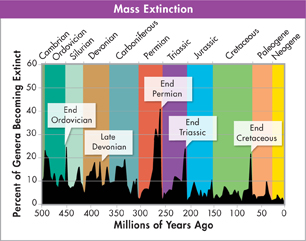Patterns of Extinction Species are always evolving and competing—and some species become extinct because of the slow but steady process of natural selection. Paleontologists use the term background extinction to describe this kind of “business as usual” extinction. In contrast, a mass extinction is an event during which many species become extinct over a relatively short period of time. A mass extinction isn't just a small increase in background extinction. In a mass extinction, entire ecosystems vanish, and whole food webs collapse. Species become extinct because their environment breaks down and the ordinary process of natural selection can't compensate quickly enough.
Until recently researchers looked for a single cause for each mass extinction. For example, geologic evidence shows that at the end of the Cretaceous Period, a huge asteroid crashed into Earth. The impact threw huge amounts of dust and water vapor into the atmosphere, causing global climate change. At about the same time, dinosaurs and many other species became extinct. It is reasonable to infer, then, that the asteroid played a significant role in this mass extinction. Many mass extinctions, however, were probably caused by several factors, working in combination: volcanic eruptions, moving continents, and changing sea levels, for example.
After a mass extinction, biodiversity is dramatically reduced. But this is not bad for all organisms. Extinction offers new opportunities to survivors. And as speciation and adaptation produce new species to fill empty niches, biodiversity recovers. But this recovery takes a long time—typically between 5 and 10 million years. Some groups of organisms survive a mass extinction, while other groups do not.
MYSTERY CLUE

Evidence indicates that before the Permian extinction, the oceans lost most of their oxygen. What effect do you think the loss of oxygen had on most organisms?
Analyzing Data
Extinctions Through Time
The graph shows how the rate of extinction has changed over time. Study the graph, and then answer the questions.
Table of Contents
- Formulas and Equations
- Applying Formulas and Equations
- Mean, Median, and Mode
- Estimation
- Using Measurements in Calculations
- Effects of Measurement Errors
- Accuracy
- Precision
- Comparing Accuracy and Precision
- Significant Figures
- Calculating With Significant Figures
- Scientific Notation
- Calculating With Scientific Notation
- Dimensional Analysis
- Applying Dimensional Analysis





